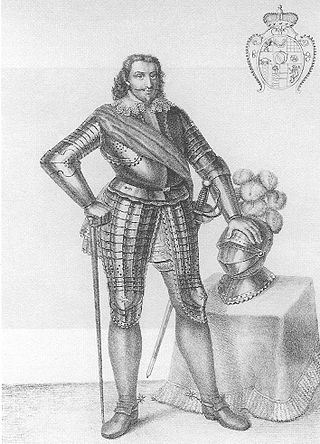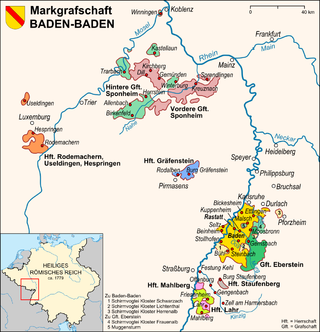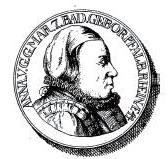
The Hochburg is a castle ruin situated between the city of Emmendingen and the village of Sexau in the region of Baden, located in the southwest of Germany. It was presumably built in the 11th century and was originally known as castle Hachberg. The line of nobles known as the Margraves of Baden-Hachberg most likely derive their name from this castle and before it was razed by the French it was the second largest fortification in Baden.

Bernard I of Baden was Margrave of the Margraviate of Baden from 1391 to 1431.

Charles II, Margrave of Baden-Durlach, nicknamed Charles with the bag, governed the Margravate of Baden-Durlach from 1552 to 1577. On 1 June 1556 Charles issued a new Church Order, which made Lutheranism the official religion in Baden-Durlach.

George Frederick of Baden-Durlach was Margrave of Baden-Durlach from 1604 until his abdication in 1622. He also ruled Baden-Baden.

Johann Pistorius, also anglicized as John Pistorius or distinguished as Johann Pistorius the Younger, was a German controversialist and historian. He is sometimes called Niddanus from the name of his birthplace, Nidda in Hesse.

Edward Fortunatus of Baden was Margrave of Baden-Rodemachern and Baden-Baden.

The Margraviate of Baden-Durlach was an early modern territory of the Holy Roman Empire, in the upper Rhine valley, which existed from 1535 to 1771. It was formed when the Margraviate of Baden was split between the sons of Margrave Christopher I and was named for its capital, Durlach. The other half of the territory became the Margraviate of Baden-Baden, located between the two halves of Baden-Durlach. Baden-Durlach became Lutheran during the Protestant Reformation, unlike Baden-Baden, which remained Catholic. Baden-Durlach occupied Baden-Baden from 1594 to 1622, but was driven out after being defeated at the Battle of Wimpfen, during the Thirty Years' War (1618-1648). The territory was ravaged during the Nine Years' War (1688-1697). Following the extinction of the Baden-Baden line in 1771, the Baden-Durlach inherited their territories and reunited the Margraviate of Baden. The reunified territory was caught up in the French Revolutionary and Napoleonic Wars, emerging in 1806 as the Grand Duchy of Baden.

Frederick V, Margrave of Baden-Durlach was a German nobleman, who ruled as margrave of Baden-Durlach from 1622 to his death. He was succeeded by his son Frederick VI, Margrave of Baden-Durlach.

The Margraviate of Baden-Hachberg was a territory of the Holy Roman Empire, in the upper Rhine valley, which existed from 1212 to 1415.

Margrave Philip of Hachberg-Sausenberg was the son of the Margrave Rudolf IV of Hachberg-Sausenberg and Margaret of Vienne. Philip reigned in 1487–1503 as Margrave of Hachberg-Sausenberg and Count of Neuchâtel. From 1466 he called himself Lord of Badenweiler.

Bernhard III, Margrave of Baden-Baden inherited in 1515 part of his father's margraviate of Baden. He ruled his part from 1515 until 1536.

The Margraviate of Baden-Baden was an early modern southwest German territory within the Holy Roman Empire. It was created in 1535 along with the Margraviate of Baden-Durlach as a result of the division of the Margraviate of Baden. Its territory consisted of a core area on the middle stretch of the Upper Rhine around the capital city of Baden, as well as lordships on the Moselle and Nahe.

Margrave Ernest I of Baden-Durlach was the founder of the so-called "Ernestine" line of the House of Baden, the line from which the later Grand Dukes descended. He was the ruling Margrave of Baden-Pforzheim from 1533 and resided in Pforzheim from 1537. In 1565, his son Charles II moved the capital to Durlach and thereby changed the name of his country to Baden-Durlach. He had to deal with the upcoming Reformation and the frequent Ottoman wars in Europe. In this turbulent time, he tried to maintain a neutral position between the Protestants and Catholics. He did not participate in the Schmalkaldic War.

Countess Palatine Anna of Veldenz was Margravine of Baden-Durlach by marriage to Charles II, Margrave of Baden-Durlach, and co-regent of the Margraviate of Baden-Durlach during the minority of her son Ernest Frederick from 1577 to 1584.

Ernest Frederick of Baden-Durlach ruled the northern part of the Margraviate of Baden-Durlach. He came to power when he came of age in 1584. He founded the first Gymnasium Illustrie in the margraviate. His conversion from Lutheranism to Calvinism and his occupation of Upper Baden caused serious conflicts – even with the Emperor – the consequences of which damaged Lower Baden and ultimately also led to losses of territory.

Margrave Rudolf II of Hachberg-Sausenberg(medieval: Rudolf II of Hachberg-Susenberg) (1301–1352) was the son of Margrave Rudolf I of Hachberg-Sausenberg and his wife Agnes, the heiress of Otto of Rötteln. After their elder brother Henry died in 1318, Rudolf II and his younger brother Otto I took up government in Rötteln and Sausenberg. They moved their seat of government from Sausenburg Castle to Rötteln Castle. In the fall of 1332, troops from the City of Basel besieged Rötteln Castle, because one of the brothers had stabbed the mayor of Basel. The conflict was settled after mediation by the nobility of the city and the margraviate.

Barbara of Württemberg was margravine of the historical German territory of Baden-Durlach. The daughter of Frederick I, Duke of Württemberg and his wife, Sibylla of Anhalt, she was born a Duchess of Württemberg and became margravine after marrying Frederick V, Margrave of Baden-Durlach, in 1616. She is depicted as Saint Barbara in a posthumous miniature portrait.
The occupation of Upper Baden refers to the occupation of the upper part of the Margraviate of Baden-Baden by troops of Margrave Ernest Frederick of Baden-Durlach under Wolf Dietrich von Gemmingen (1550–1601) on 21 November 1594, and its subsequent administration which lasted until 1622.

















